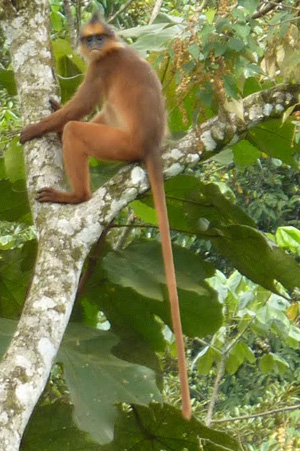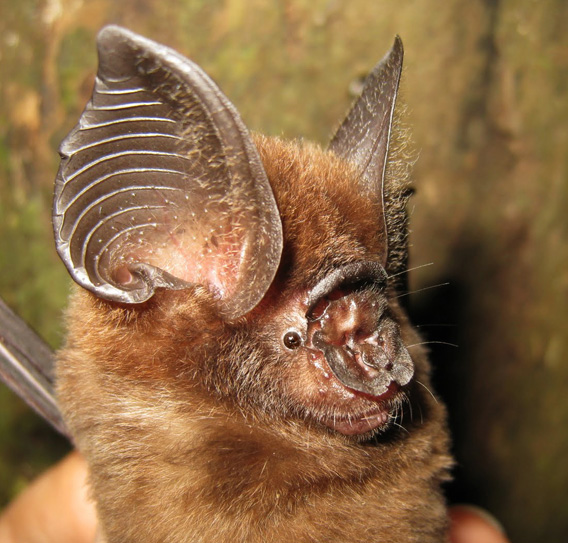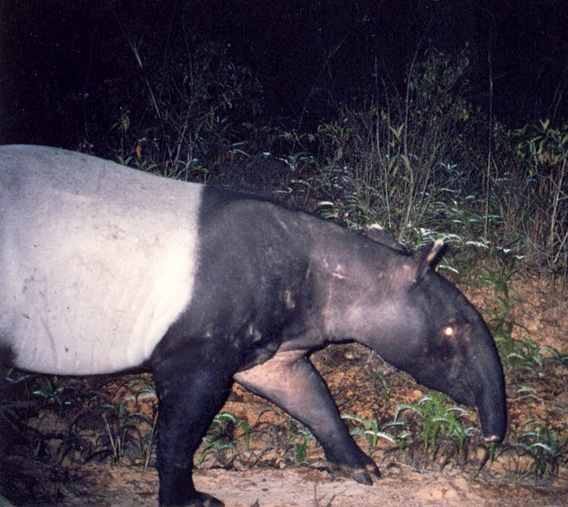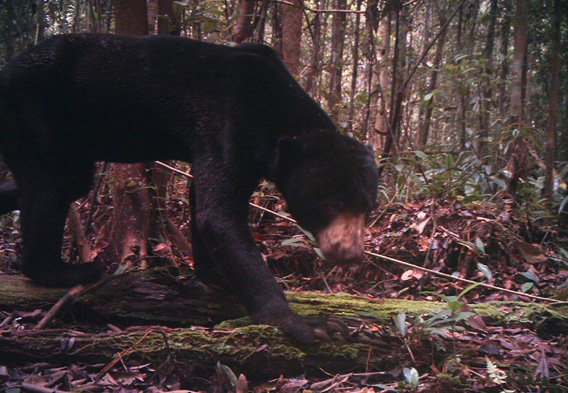Researchers have uncovered an astounding number of species in a tiny protected forest fragment surrounded on all side by palm oil plantations in the Indonesian island of Sumatra. Researchers with the Zoological Society of London (ZSL), Queen Mary, University of London and the Durrell Institute of Conservation and Ecology (DICE – University of Kent) recorded sun bear (Helarctos malayanus), Malayan tapir (Tapirus indicus), the banded langur (Presbytis femoralis), and agile gibbons (Hylobates agilis), but most notable, was the first record ever of the Ridley’s leaf-nosed bat (Hipposideros ridleyi) in Sumatra. The discoveries highlight the importance of preserving even small forest fragments surrounded by agriculture.
“Protecting large areas of connected forest will always be a priority for wildlife conservation, but if ambitious future plans for oil palm expansion are realized, conserving forest fragments within oil palm landscapes will also be important for maintaining Indonesia’s biodiversity,” said Sophie Persey, ZSL Biodiversity and Oil Palm Project Manager, in a press release.
 The banded langur (Presbytis femoralis) is classified as Near Threatened by the IUCN Red List. Like most other animals in the region, the banded langur is threatened by habitat loss. Photo courtesy of ZSL. |
The wildlife was recorded in a 300 hectare (741 acres) forest fragment that is managed as a conservation area by the palm oil company. Many of the species discovered are globally endangered, including Ridley’s leaf-nosed bat (Hipposideros ridleyi), which is classified as Vulnerable by the IUCN Red List.
“This species is a forest specialist species as it depends on the availability of large hollows in forest trees to roost in and would therefore be unable to survive in an oil palm monoculture,” Persey told the Jakarta Globe.
Sumatra is a major battleground for deforestation in Asia. The Indonesian island has lost 40% of its lowland forests in just 15 years, from 1990 to 2005, largely due to industrial monoculture expansion, such as palm oil and pulp and paper, and logging. The island is the only place in the world where orangutans, tigers, elephants, and rhinos all survive, though in ever-dwindling populations.
“The finding of this survey suggests that a network of forest fragments may be appropriate for some species of high conservation concern. The scientific community needs to continue to support the business community to find ways in which our threatened wildlife can persist in these managed areas over the long-term,” says survey-leader Dr. Matthew Struebig of Queen Mary, University of London and DICE.

The first recorded Ridley’s leaf-nosed bat (Hipposideros ridleyi) in Sumatra. Photo by: Matthew Struebig.

The Malayan tapir is classified as Endangered by the IUCN Red List with its population on the decline. Habitat loss and hunting are the biggest threats. Photo courtesy of ZSL.

The sun bear is classified as Vulnerable by the IUCN Red List. Like the tapir it is threatened by habitat loss and hunting. Photo courtesy of ZSL.
Related articles
Video: camera trap catches bulldozer clearing Sumatran tiger habitat for palm oil
(10/14/2010) Seven days after footage of a Sumatran tiger (Panthera tigris sumatrae) was taken by a heat-trigger video camera trap, the camera captured a bulldozer clearing the Critically Endangered animal’s habitat. Taken by the World Wildlife Fund—Indonesia (WWF), the video provides clear evidence of forest destruction for oil palm plantations in Bukit Batabuh Protected Forest, a protected area since 1994.
Fighting poachers, going undercover, saving wildlife: all in a day’s work for Arief Rubianto

(09/29/2010) Arief Rubianto, the head of an anti-poaching squad on the Indonesian island of Sumatra best describes his daily life in this way: “like mission impossible”. Don’t believe me? Rubianto has fought with illegal loggers, exchanged gunfire with poachers, survived four days without food in the jungle, and even gone undercover—posing as a buyer of illegal wildlife products—to infiltrate a poaching operation. While many conservationists work from offices—sometimes thousands of miles away from the area they are striving to protect—Rubianto works on the ground (in the jungle, in flood rains, on rock faces, on unpredictable seas, and at all hours of the day), often risking his own life to save the incredibly unique and highly imperiled wildlife of Sumatra.
Large-scale forest destruction in Sumatra undermines Indonesia’s deal with Norway

(07/13/2010) While the Indonesian government basks in a recent agreement with Norway to slow deforestation to the tune of a billion US dollars, a new report by Eyes on the Forest shows photographic evidence of largely government sanctioned deforestation that flouts several Indonesia laws. Potentially embarrassing, the report and photos reveal that two companies, Asian Pulp and Paper (APP) and Asia Pacific Resource International (APRIL), have destroyed 5 percent of Riau province’s forests since 2009, including deep peatlands, high conservation value forests (HCVF), Critically Endangered Sumatran tiger habitat, and forest within the Giam Siak Kecil- Bukit Batu UNESCO Biosphere Reserve. In total, over 130,000 hectares (an area larger than Hong Kong) of mostly peat forest were destroyed for pulp.
Indonesia’s plan to save its rainforests

(06/14/2010) Late last year Indonesia made global headlines with a bold pledge to reduce deforestation, which claimed nearly 28 million hectares (108,000 square miles) of forest between 1990 and 2005 and is the source of about 80 percent of the country’s greenhouse gas emissions. President Susilo Bambang Yudhoyono said Indonesia would voluntarily cut emissions 26 percent — and up to 41 percent with sufficient international support — from a projected baseline by 2020. Last month, Indonesia began to finally detail its plan, which includes a two-year moratorium on new forestry concession on rainforest lands and peat swamps and will be supported over the next five years by a one billion dollar contribution by Norway, under the Scandinavian nation’s International Climate and Forests Initiative. In an interview with mongabay.com, Agus Purnomo and Yani Saloh of Indonesia’s National Climate Change Council to the President discussed the new forest program and Norway’s billion dollar commitment.
Indonesian government report recommends moratorium on peatlands conversion
(01/19/2010) A study issued by Indonesian government recommends a moratorium on peatlands conversion in order to meet its greenhouse gas emissions target pledged for 2020, reports the Jakarta Post. The report, commissioned by the National Development Planning Agency (Bappenas), says that conversion of peatlands accounts for 50 percent of Indonesia’s greenhouse gas emissions but only one percent of GDP. A ban on conversion would therefore be a cost-effective way for the country to achieve its goal of reducing carbon emissions 26 percent from a projected baseline by 2020. But the recommendation is likely to face strong resistance from plantation developers eager to expand operations in peatland areas. Last year the Agricultural Ministry lifted a moratorium on the conversion of peatlands of less than 3 meters in depth for oil palm plantations. Environmentalists said the move would release billions of tons of carbon dioxide.
Video: rare footage of the sun bear, the world’s smallest, making a nest in the canopy
(12/06/2009) Sun bear expert, Siew Te Wong, has captured rare footage of the world’s smallest bear making a nest high in the canopy. The sun bear in the video is a radio-collared individual that Wong is keeping tabs on in Borneo.
Face-to-face with what may be the last of the world’s smallest rhino, the Bornean rhinoceros

(12/01/2009) Nothing can really prepare a person for coming face-to-face with what may be the last of a species. I had known for a week that I would be fortunate enough to meet Tam. I’d heard stories of his gentle demeanor, discussed his current situation with experts, and read everything I could find about this surprising individual. But still, walking up to the pen where Tam stood contentedly pulling leaves from the hands of a local ranger, hearing him snort and whistle, watching as he rattled the bars with his blunted horn, I felt like I was walking into a place I wasn’t meant to be. As though I was treading on his, Tam’s space: entering into a cool deep forest where mud wallows and shadows still linger. This was Tam’s world; or at least it should be.